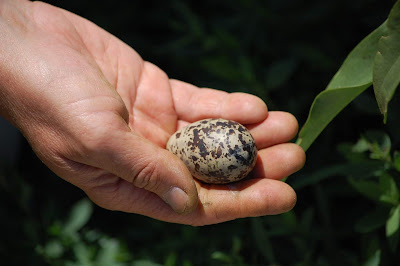The North American population of an endangered seabird,
most of which nest on a few small islands in Buzzards Bay, is higher than at
any time since 1987, providing scientists with a feeling of optimism following
a period of decline in the 2000s that had them worried about the birds’ future.
Yet the roseate tern – a gull-like bird with a
black cap, pointed wings and a sharp beak – still faces threats from predators
and climate change that require constant vigilance so the recent gains are not
lost.
Ninety percent of the population nests on three
islands – Bird Island and Ram Island in Buzzards Bay, each of which are home to
about 1,100 nesting pairs, and Great Gull Island off the eastern end of Long
Island, where 1,800 pairs nest. The remaining 400 pairs nest on a dozen islands
scattered from Nova Scotia to New York.
“We don’t know what caused the decline, just as we
don’t know what’s causing the
Mostello and a team of eight biologists and
students are spending almost every day of
 |
| Roseate tern (Todd McLeish) |
Gulls, which eat the eggs and chicks, are the primary predators on the terns, so the research team does its best to keep gulls from nesting on the islands and discourage them from getting close to the tern nests. Peregrine falcons are also an occasional concern, since they will
 |
| Roseate tern colony on Bird Island, Mass. (Todd McLeish) |
Climate change is a growing worry as
well, according to Mostello. Because the islands are very low-lying – Bird
Island’s maximum elevation is just 10 feet – erosion and sea level rise could
reduce nesting habitat, and major storms could flood active nests.
Offshore wind turbines are also an
increasing threat, especially with hundreds of turbines proposed by Bay State
Wind and Vineyard Wind for the waters just south of the breeding islands.
“Those are areas that the roseates
fly through, so we’re really concerned about those projects,” Mostello said. “Even
if each turbine doesn’t kill a lot of birds per year, they’ll be
operational
for a lot of years, and when you have a rare species that’s long-lived and
produces few young per year, it starts to knock down the survival rate and
could have an impact on the population. Hundreds of turbines could be a big
risk to the terns.”
 |
| Roseate tern egg (Todd McLeish) |
In an effort to boost the birds’
population, Mass Wildlife teamed with the Army Corps of Engineers and a number
of other partners to restore habitat at Bird Island. By filling in some
low-lying areas, planting native vegetation and increasing the height of the
sea wall, the project has doubled the amount of potential nesting habitat on
the two-acre island.
“Before the restoration, the birds
were very crowded, and that resulted in a lot of agonistic interactions,” said
Mostello. “Their territories were small, so neighboring adults were attacking
other adults and chicks, resulting in lower productivity. Now they can spread
out a bit, they’re less aggressive towards each other, and the substrate is
better for them. We have more habitat and it’s better habitat.”
A similar habitat restoration
project is in the planning stages for Ram Island.
Despite the improved habitat and recent
population increase, however, Mostello isn’t ready to claim victory for the
birds.
“If you have a population that
fluctuates a lot – we went from 2,900 pairs to 4,400 pairs in six years – you
would want to wait a while to make sure the population was actually stable
before you considered them recovered,” she said. “They could be headed for a
downturn. The rate of increase has slowed. It could be that we’re headed for a
leveling off and a decline. Only time will tell.”
So she will continue to spend almost
every day of the breeding season keeping an eye on the roseate terns in
Buzzards Bay, knowing that their progress could easily be reversed without a
regular human presence.
“If we didn’t show up, we might get
away with it for a year, but by the second year you’d have predators that knew
they could feed uninhibited on the terns, you’d see declines in productivity,
and partial or full abandonment of the colony,” she said. “Having a human
presence is non-negotiable.
“While we need to continue to shepherd them
through the world, we’ll do it with the hope that someday they’ll be
self-sufficient and won’t need this level of effort,” Mostello concluded.
“We’ve been committed to this species for a long time – we have a huge
responsibility here in Massachusetts with 50 percent of the continental
population here – so we’re not about to slack off and lose the gains that we’ve
made.”This article first appeared on EcoRI.org on July 8, 2019.
No comments:
Post a Comment